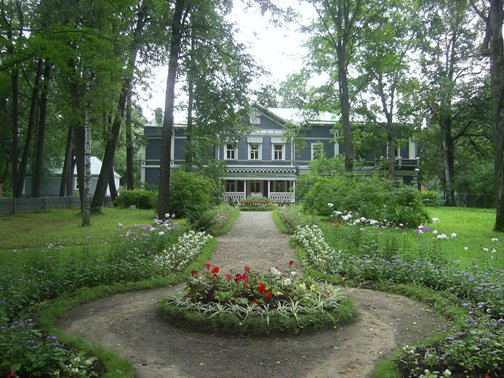

Location: Klin, Ulitsa Tchaikovskaya 48, 90 km (55 mi) Northwest of Moscow
Tchaikovsky House Museum (Дом- музей П.И. Чайковского) is located in
the city of Klin, 90 km (55 mi) Northwest of Moscow. Tchaikovsky
House-Museum (Дом-музей Чайковского), Chaikovskogo st, 18 (Located
in the center of the town. If you ride by bus 437, ask the driver to
stop at the Chaikovsky square (Сквер Чайковского) and go ahead), ☎
+7 95 539-81-96, fax: +7 95 539-84-67, e-mail: gdmch@dol.ru. 10:00 -
18:00, except Wednesday, Thursday and the last Monday of the month.
Box office until 17:00. The museum was founded in 1894. Fee 280 RUB.
This modest, but cozy residence once belonged to a local judge
V.S. Sakharov was also a residence for the famous Russian composer
P.I. Tchaikovsky since May 1892 till his death. Shortly after death
of a Tchaikovsky, his residence became a museum. Tchaikovsky's
residence was fully preserved along with a personal archives, his
books along with personal items and furniture. In 1916 the house was
transferred to a Moscow branch of the Russian Musical Society. Thus
this organization fulfilled the last will of composer's brother
Modest Ilyich Tchaikovsky.
In 1921 the building was
nationalized by a newly established Soviet government. Unlike many
other private residencies the house of Tchaikovsky was never looted
even during Russian Revolution of 1917 and subsequent Civil War.
Apparently it was too far from Moscow to experience any upheavals of
civil unrest. The composer chose this place exactly for this reason,
to escape the big metropolis. However during onset of World War II
parts of the museum had to be evacuated from the approaching German
troops. Whatever wasn't saved by the workers of museum, was looted
and destroyed by the Germans.
However most of interior of
Tchaikovsky House Museum was preserved and later returned to the
original estate, once the Nazi army was defeated. All the
furnishings, over 200 of his personal belongings, library and
archive is still preserved in this quiet residence. In addition to a
personal house where Tchaikovsky once lived Memorial Museum Preserve
Tchaikovsky also includes a beautiful park and a personal estate
"Demyanovo". It was personal home of Sergei Ivanovich Taneyev,
favorite pupil of Tchaikovsky. In addition to exhibition halls and
personal items Tchaikovsky House Museum holds small concerts in the
same rooms where they were played for the first time.
In 1916, according to the will of the composer's brother Modest
Ilyich Tchaikovsky, the house, originally purchased by him in the name
of the composer's servant Alexei Sofronov, and then resold to
Tchaikovsky's nephew Vladimir Davydov, was transferred to the Moscow
branch of the Russian Musical Society with the condition that it would
be preserved and maintained.
At the end of January 1918, the
house was preserved intact thanks to the efforts of N. A. Alekseev. In
1921, the museum was nationalized by the Bolsheviks.
The museum
suffered greatly during the Great Patriotic War. Documentary footage of
the aftermath of the looting of the house-museum by German troops is
presented in the Soviet film "The Defeat of German Troops near Moscow".
The museum collection contains over 200 thousand items. In addition
to the P. I. Tchaikovsky fund, the museum contains funds of the
Tchaikovsky-Davydov family, the personal funds of M. I. Tchaikovsky and
Russian musicians from P. I. Tchaikovsky's circle. The museum collection
includes paintings by K. and V. Makovsky, B. Kustodiev, V.
Byalynitsky-Birulya and many others. Since 1958, the museum has kept the
fund of the history of the International Tchaikovsky Competitions.
In recent years, the museum's collection has been actively
replenished. Among the recently opened funds is the personal fund of
outstanding musicians of the 20th century: cellist Daniil Shafran and
pianist Emil Gilels.
The museum includes the memorial house of P.
I. Tchaikovsky, the estate park and buildings on its territory, an
outbuilding with an exhibition dedicated to Tchaikovsky's favorite
student S. I. Taneyev, as well as the nearby estates "Frolovskoye",
"Maidanovo" and "Demyanovo", where Tchaikovsky lived or visited. The
estate "Demyanovo" belonged to the elder brother of the composer S. I.
Taneyev, the famous lawyer V. I. Taneyev.
On the territory of the
museum there is an administrative building, including a concert hall,
two exhibition halls, an audio hall and a storage building.
In
2019, the museum-reserve was included in the program of digitalization
of Moscow region museums, within the framework of which in July of the
same year the only sound sculpture in Russia, "Melody of Light", was
installed here. It was developed in St. Petersburg specifically for the
Pyotr Ilyich Tchaikovsky Museum-Reserve, and has no analogues not only
in Russia, but also in the world. The sculpture in the form of a
vertical two-meter LED rod, reminiscent of the shape of a sound wave,
reproduces a unique sound range and color palette depending on the
activity of the viewers at the installation. By default, the sculpture
is loaded with Pyotr Tchaikovsky's works "The Seasons" and "Children's
Album".
Among the projects carried out by the museum-reserve is a
new reconstruction of Tchaikovsky's Symphony in E-flat major by Russian
musicologist and composer Pyotr Klimov. The performance of the Symphony
by the State Academic Symphony Orchestra of Russia under the direction
of Tomomi Nishimoto took place here on June 5, 2006. It was recorded on
video and made freely available on YouTube.